

Bombing of Hiroshima and Nagasaki - World War II. Hiroshima, a manufacturing center of some 350,000 people located about 500 miles from Tokyo, was selected as the first target.
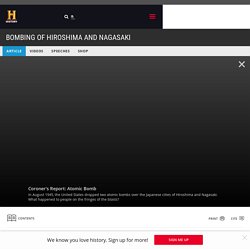
After arriving at the U.S. base on the Pacific island of Tinian, the more than 9,000-pound uranium-235 bomb was loaded aboard a modified B-29 bomber christened Enola Gay (after the mother of its pilot, Colonel Paul Tibbets). The plane dropped the bomb–known as “Little Boy”–by parachute at 8:15 in the morning, and it exploded 2,000 feet above Hiroshima in a blast equal to 12-15,000 tons of TNT, destroying five square miles of the city. Hiroshima’s devastation failed to elicit immediate Japanese surrender, however, and on August 9 Major Charles Sweeney flew another B-29 bomber, Bockscar, from Tinian.
Thick clouds over the primary target, the city of Kokura, drove Sweeney to a secondary target, Nagasaki, where the plutonium bomb “Fat Man” was dropped at 11:02 that morning. Access hundreds of hours of historical video, commercial free, with HISTORY Vault. Hiroshima Hoax: Japan's 'Wllingness to Surrender Before the Bomb. In the mid 1960's, a growing distrust of government and sympathy for the Vietnam protest movement among American intellectuals revitalized the antinuclear "ban the bomb" campaign, which few had taken very seriously before, and spurred criticism of the use of atomic weapons to end World War II.

Since then, "enlightened opinion" has been dominated by a revisionism fueled by seductive tales of conspiracy in high places, unabashed fact bending, and manipulation of the historical record. Historian Robert James Maddox maintains in "The Greatest Hoax In American History: Japan's Alleged Willingness to Surrender During the Final Months of World War II" (History News Network) that this is exactly what was done by Kai Bird and Martin J. Sherwin in their Pulitzer Prize-winning American Prometheus: The Triumph and Tragedy of J. 29.pdf. The Japanese offered to surrender before America dropped Atomic Bombs on them! "It is my opinion that the use of this barbarous weapon at Hiroshimaand Nagasaki was of no material assistance in our war against Japan.
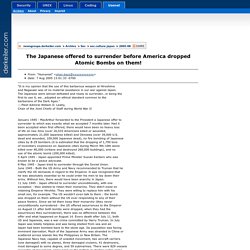
The Japanese were almost defeated and ready to surrender...in being the first to use it, we...adopted an ethical standard common to the barbarians of the Dark Ages. " ---Fleet Admiral William D. Leahy, Chair of the Joint Chiefs of Staff during World War II January 1945 - MacArthur forwarded to the President a Japanese offer to surrender to which was exactly what we accepted 7 months later. Was the Atomic Bombing of Japan Necessary? Few issues in American history - perhaps only slavery itself - are as charged as the dropping of the atomic bombs on Japan.
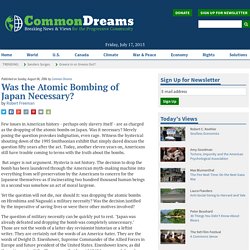
Was it necessary? Merely posing the question provokes indignation, even rage. Witness the hysterical shouting down of the 1995 Smithsonian exhibit that simply dared discuss the question fifty years after the act. The REAL Reason America Used Nuclear Weapons Against Japan. Atomic Weapons Were Not Needed to End the War or Save Lives Like all Americans, I was taught that the U.S. dropped nuclear bombs on Hiroshima and Nagasaki in order to end WWII and save both American and Japanese lives.
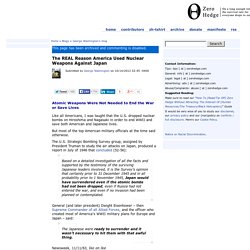
But most of the top American military officials at the time said otherwise. Real History, the Bomb, and the War against Japan. DAVID IRVING* reveals that the Allies were aware of Japanese attempts to quit the war before Hiroshima.
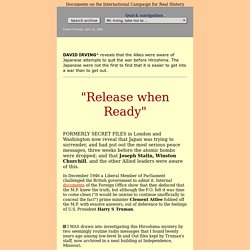
The Japanese were not the first to find that it is easier to get into a war than to get out. "Release when Ready" FORMERLY SECRET FILES in London and Washington now reveal that Japan was trying to surrender, and had put out the most serious peace messages, three weeks before the atomic bombs were dropped; and that Joseph Stalin, Winston Churchill, and the other Allied leaders were aware of this. Real History, the Bomb, and the War against Japan. VJ - Hirohito. Real History, Japan, and Churchill's War. Real History, Japan, and Churchill's War. Real History, Japan, and Churchill's War. Top Secret-Ultra reports (NARS number: SRH 084, headed Russo-Japanese Relations) [My summary:] Early in June 1945 the Japanese Foreign Minister Shigenoria Togo advised Ambassador Sato in Moscow that it was a matter of 'the utmost urgency' to prevent Russia from entering the Pacific War.
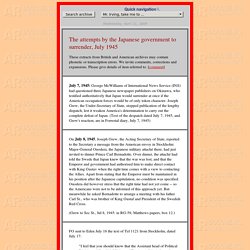
In the first two weeks of June, former prime minister Hirota conducted at Togo's request four conversations with Soviet ambassador Malik in Moscow (TOKYO?). This became plain from a June 28 message from Togo, from Tokyo to Moscow (See diplomatic summary 61195, dated July 3). Ambassador Malik did not however hold out much hope of providing the kind of friendly assistance that the Japanese were asking for.
Two days later, on June 30, after a 7,000 ton TNT bombing raid, Foreign Minister Togo sent an extremely urgent despatch to Sato. Real History and the atomic bombing of Japan. Real History, the Bomb, and the War against Japan. Real History, the Bomb, and the War against Japan. Japan Tried To Surrender After Midway Defeat. Was Hiroshima Necessary? Was Hiroshima Necessary?

Why the Atomic Bombings Could Have Been Avoided By Mark Weber On August 6, 1945, the world dramatically entered the atomic age: without either warning or precedent, an American plane dropped a single nuclear bomb on the Japanese city of Hiroshima. The explosion utterly destroyed more than four square miles of the city center. About 90,000 people were killed immediately; another 40,000 were injured, many of whom died in protracted agony from radiation sickness.
Surrender of Japan. On August 6, 1945, at 8:15 AM local time, the United States detonated an atomic bomb over the Japanese city of Hiroshima.
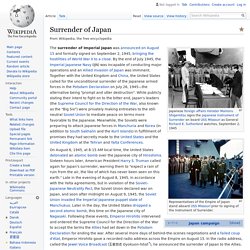
Sixteen hours later, American President Harry S. Truman called again for Japan's surrender, warning them to "expect a rain of ruin from the air, the like of which has never been seen on this earth. " Late in the evening of August 8, 1945, in accordance with the Yalta agreements, but in violation of the Soviet–Japanese Neutrality Pact, the Soviet Union declared war on Japan, and soon after midnight on August 9, 1945, the Soviet Union invaded the Imperial Japanese puppet state of Manchukuo. Later in the day, the United States dropped a second atomic bomb, this time on the Japanese city of Nagasaki. Following these events, Emperor Hirohito intervened and ordered the Supreme Council for the Direction of the War to accept the terms the Allies had set down in the Potsdam Declaration for ending the war.
The Real Reason America Used Nuclear Weapons Against Japan. It Was Not To End the War Or Save Lives. Like all Americans, I was taught that the U.S. dropped nuclear bombs on Hiroshima and Nagasaki in order to end WWII and save both American and Japanese lives.
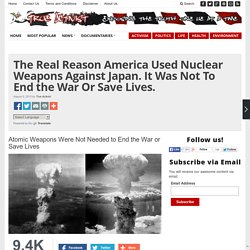
But most of the top American military officials at the time said otherwise. The U.S. Strategic Bombing Survey group, assigned by President Truman to study the air attacks on Japan, produced a report in July of 1946 that concluded (52-56): Carnegie Council for Ethics in International Affairs. Speaker: Ward Wilson, Monterey Institute of International Studies Transcript: Nuclear weapons shocked Japan into surrendering at the end of World War II—except they didn’t. Japan surrendered because the Soviet Union entered the war. Japanese leaders said the bomb forced them to surrender because it was less embarrassing to say they had been defeated by a miracle weapon. Japan's Quest for Power and World War II in Asia. The World at War: 1931-1945 Economic Background While the United States was still struggling to emerge from the Great Depression at the end of the 1930s, and would do so partly because of the war, Japan had emerged from its own period of depression, which had begun in 1926, by the mid-1930s.
Many of the young soldiers mobilized into the Japanese army by the early 1930s came from the rural areas, where the effects of the depression were devastating and poverty was widespread. Their commitment to the military effort to expand Japanese territory to achieve economic security can be understood partly in these terms. The depression ended in the mid-1930s in Japan partly because of government deficits used to expand greatly both heavy industry and the military.
"1945-1998" by Isao Hashimoto: CTBTO Preparatory Commission. Hiroshima: The Complete Series 5-8. Hiroshima: The Complete Series 4-8. Hiroshima: The Complete Series 3-8. Hiroshima: The Complete Series 3-8. Hiroshima: The Complete Series 2-8. Hiroshima: The Complete Series 1-8. Hiroshima: The Complete Series 6-8. Hiroshima: The Complete Series 7-8. Hiroshima: The Complete Series 8-8. Tale of Two Cities: Hiroshima and Nagasaki - Atomic Bomb Blast - Part 1 (1946) Tale of Two Cities: Hiroshima and Nagasaki - Atomic Bomb Blast - Part 2 (1946) Japanese Films of Hiroshima, August 5, 1946 (Universal Newsreel) Hiroshima Aftermath 1946 USAF Film. Hiroshima and Nagisaki. World War II in HD: Iwo Jima. 84769-hiroshima.jpg (850×619) Video - The U.S. War Department's Archival Footage of the Bombing of Hiroshima. Hiroshima after the Atomic Bomb (3 of 5) by Harbert F Austin Jr. The eight islands of Japan sprang into existence through Divine Intervention.
The first two gods who came into existence were Izanagi no Mikoto and Izanami no Mikoto, the Exalted Male and Exalted Female. It was their job to make the land for people to live on. Hiroshima Atomic Bombing Remembered with Google Earth. During the final days of World War II, the United States dropped devastating atomic bombs on Hiroshima and Nagasaki. More than 65 years later, Hidenori Watanave, an associate professor of Tokyo Metropolitan University, has created a digital archive to preserve the memory of the Hiroshima bombing. A complement to the Nagasaki archive launched in 2010, the Hiroshima Archive layers historical resources into Google Earth, giving users the chance to explore a panoramic view of Hiroshima, survivor accounts, aerial photos, 3D topographical data, and building models.
The documents are all written in Japanese, which creates something of a language barrier for many readers. But a tour through the archive will tell you something important — something important about the Hiroshima bombing and how we’re memorializing the past in our new digital age. Related Content: JAPANESE CONQUEST OF MANCHURIA 1931-1932. Attack of September 18, 1931 ON SEPTEMBER 18, 1931 Japan launched an attack on Manchuria. Within a few days Japanese armed forces had occupied several strategic points in South Manchuria. The United States Minister to China reported to Secretary of State Stimson, in a telegram dated September 22, his opinion that this was "an aggressive act by Japan", apparently long-planned, and carefully and systematically put into effect. Minister Johnson found no evidence that it was the result of accident or the act of minor and irresponsible officials.
What Nagasaki looked like before and after the bomb. Korematsu v. United States. Our Documents - Executive Order 9066: Resulting in the Relocation of Japanese (1942)